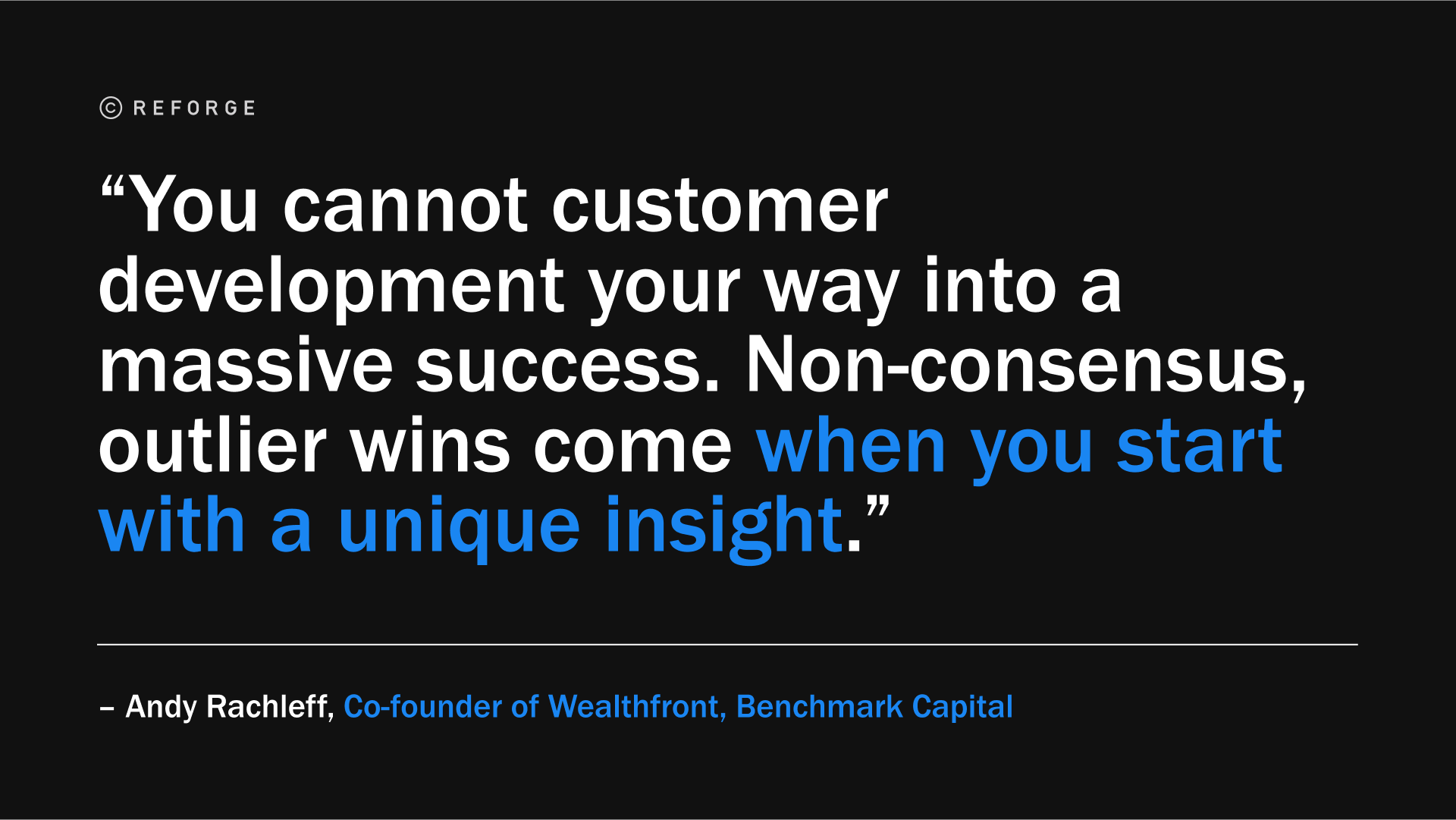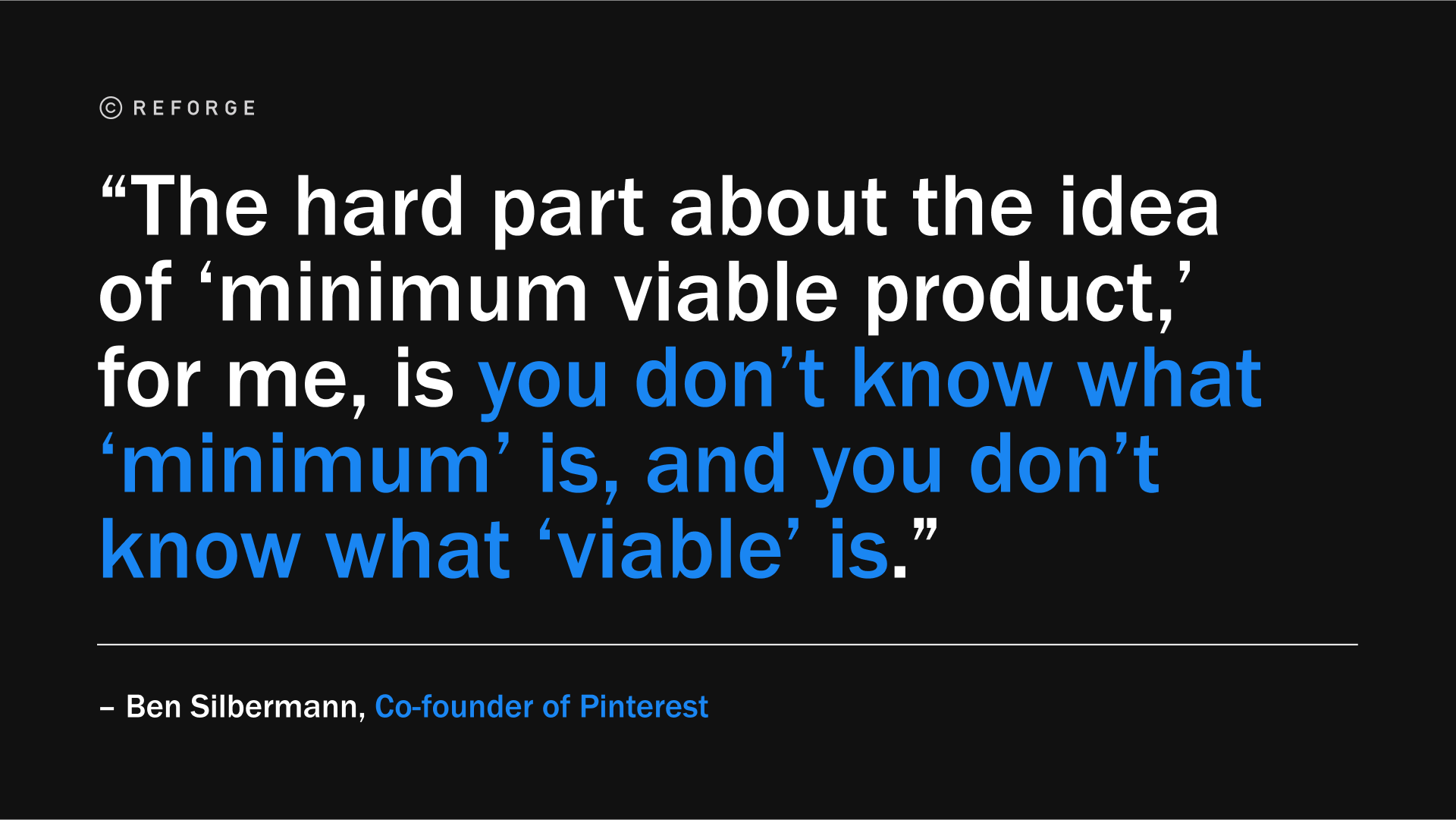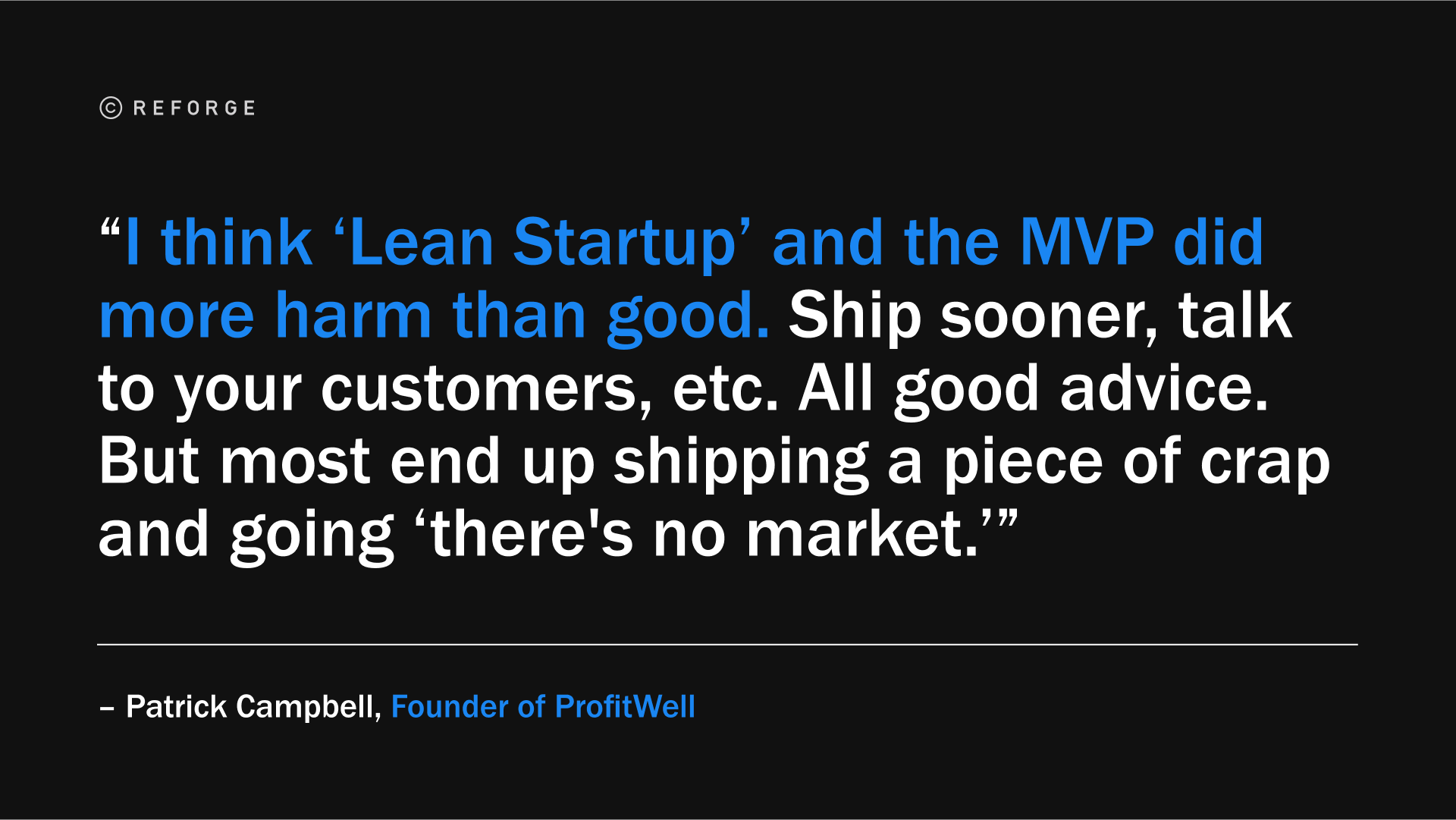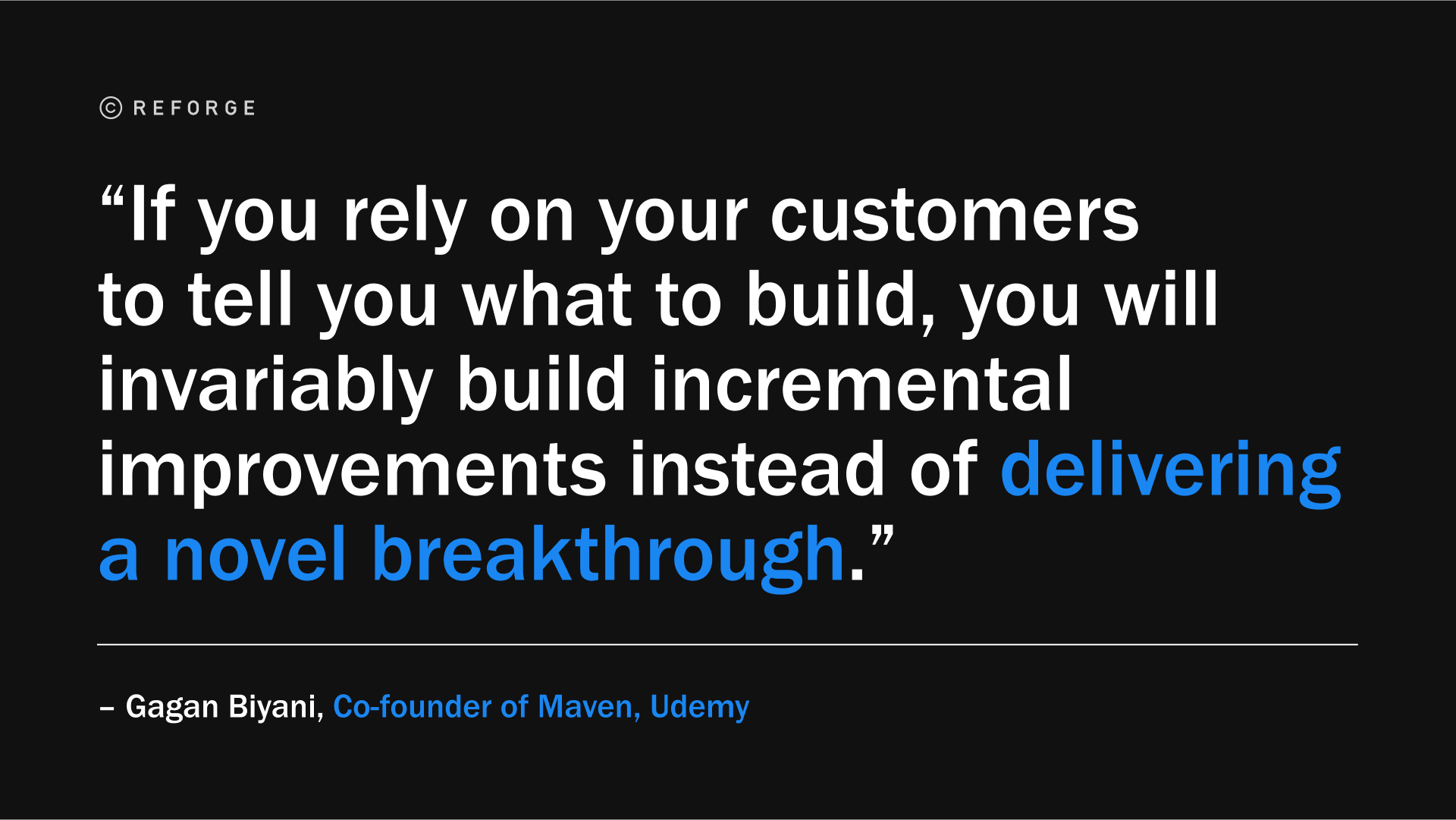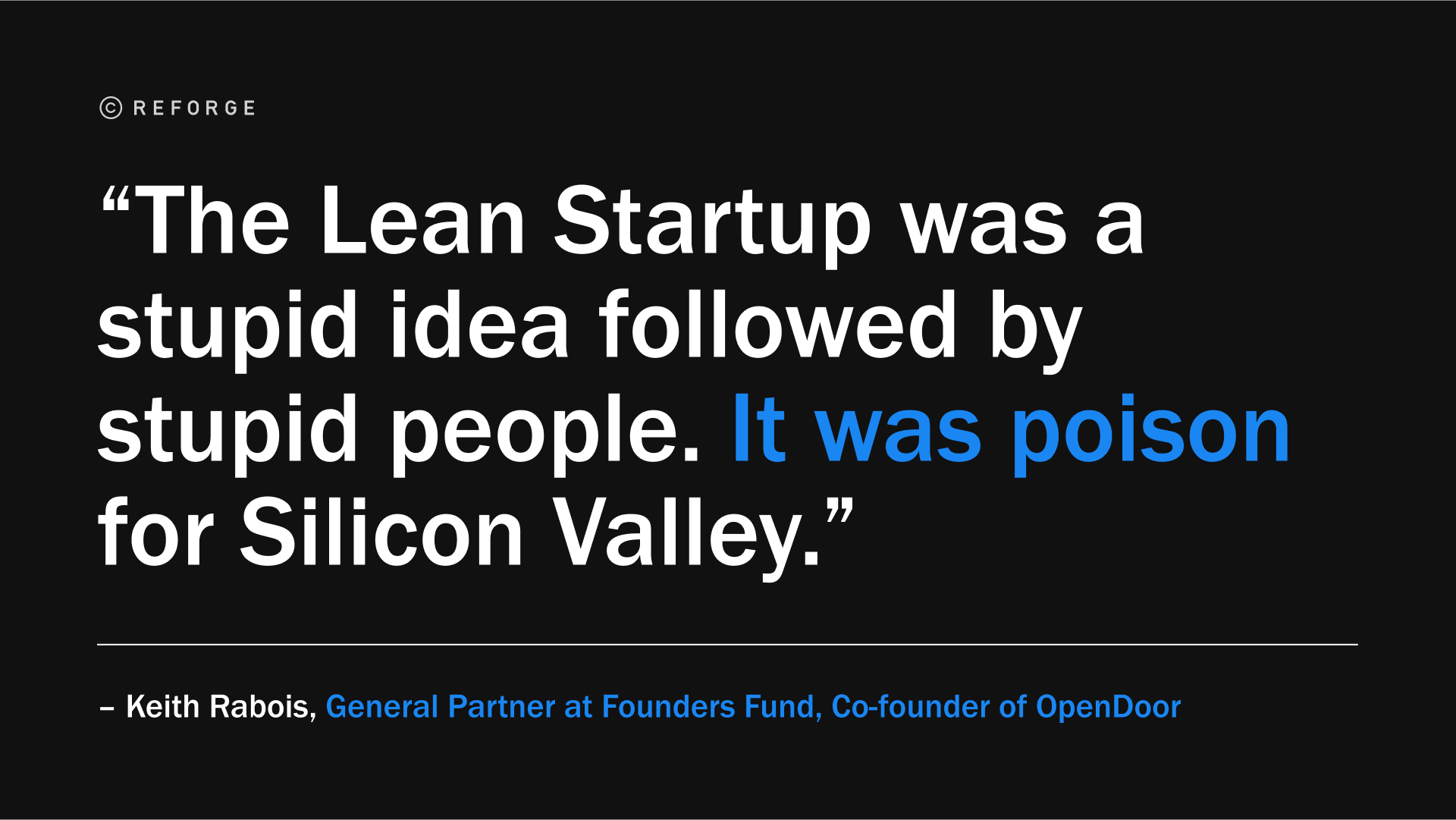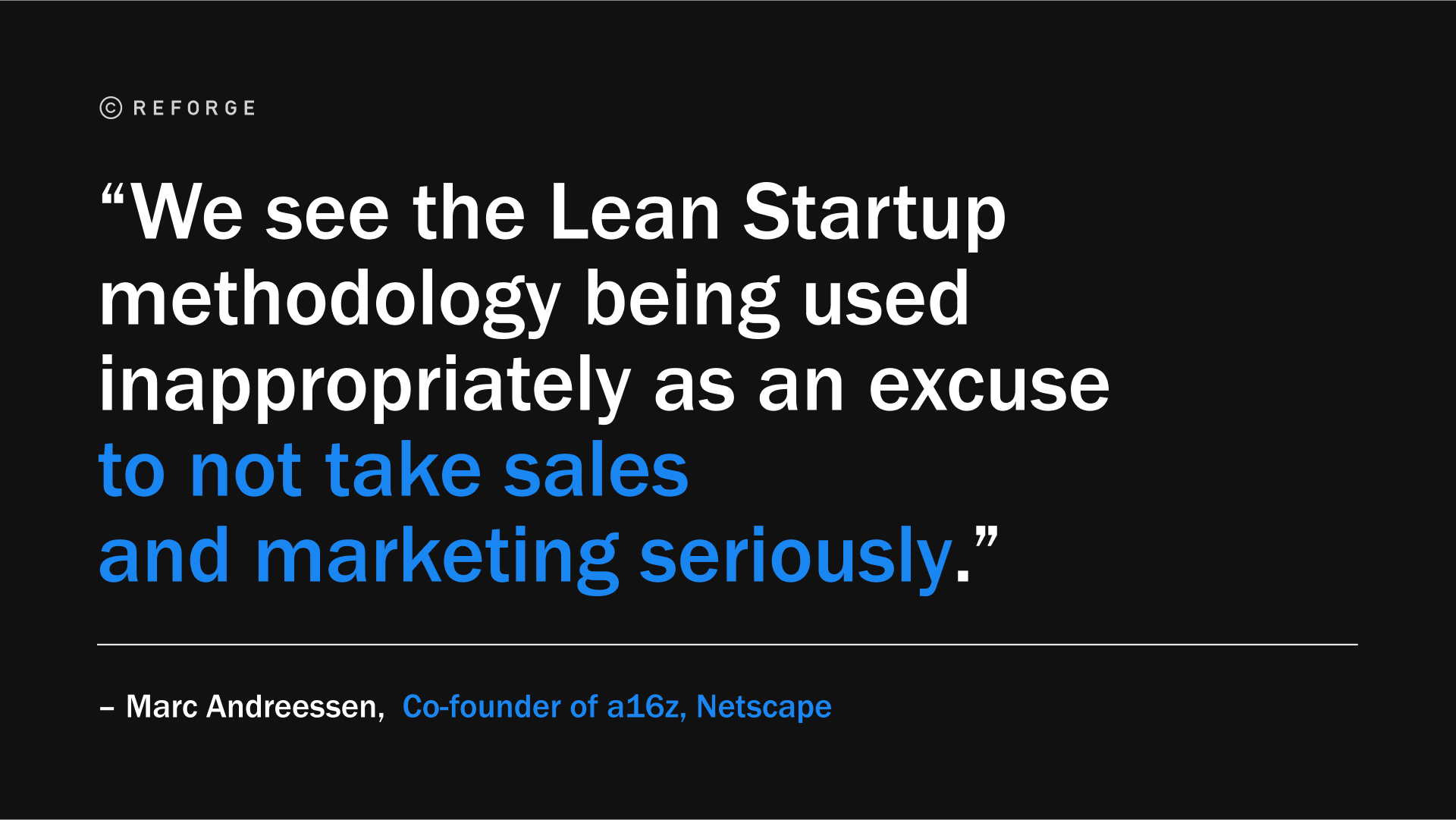I still remember reading Eric Ries’ blog post that first coined the term “Lean Startup” in September 2008.
It fully encapsulated a new way to build startups that was starting to take hold in Silicon Valley.
The methodology had caught lightning in a bottle, with entrepreneurs worldwide immediately embracing its core concepts, like MVPs, validated learning, pivots, and more.
When I founded my first startup, Anywhere.FM, our team leveraged many of the core principles of the Lean methodology to build a web music player.
Just as Lean recommended, we hurried an MVP to market in a matter of months and got tons of early feedback from customers.
But despite following Lean methodology to the letter, garnering glowing press reviews, and growing to over 100,000 users, we still ultimately failed to find product/market fit. And in turn, we were never able to find a viable business model for our product.
While the team was ultimately acqui-hired by imeem for the impressive tech we had developed, our dreams of building an independent web music player were over.
While we were working on Anywhere.FM, we came across another small music startup founded by Daniel Ek in Sweden. We didn't think much of the startup at the time because its team had spent two years just building a product before ever launching it.
Given the company’s slow pace of innovation, which contradicted the core principles of Lean, we assumed they wouldn't amount to much.
But as we know, Daniel Ek's “little” startup called Spotify went on to revolutionize the entire music industry and popularize the music streaming paradigm we all take for granted today.
There Has To Be A Better Way
The experience of watching Spotify's meteoric rise, while failing on Anywhere.FM, led me to become obsessed with isolating what separates those brands that find true product-market fit from the rest.
This fixation fueled my desire to build a new successful startup, as well as find a better process for doing so.
Over the past few years, I’ve become skeptical of whether “The Lean Startup” was really the best guide for new product innovation.
And I ultimately came to appreciate that I wasn’t alone.
In the past decade since the Lean Startup’s introduction, many seasoned entrepreneurs have come to believe that it largely fails at the very thing it sought to accomplish: enabling entrepreneurs to more predictably and successfully bring new products to market.
While experienced entrepreneurs have largely moved beyond the Lean Startup methodology, first-time founders still use it as their primary playbook. Those new founders are then extremely frustrated when that methodology doesn't actually help them build a successful company.
That’s why I think it's important to bring greater awareness to the many limitations of the Lean Startup. As well as share an alternative approach I developed that can serve as a better guide for new product innovation called The Deliberate Startup.
You can learn more about how to truly find Product Market Fit using The Deliberate Startup method in our newest program, Finding Product/Market Fit:
However, before we start diving deep into a new method, it’s important to understand why the Lean Startup has become so ineffective.
Startup veterans from the likes of PayPal, Wealthfront, Pinterest, Netscape, and more, have identified four core challenges with the Lean Startup:
It encourages agnostic experimentation instead of starting with a compelling strategy
It stresses the need for minimum viable products, which can lead to failing too fast
It results in developing incremental products, not product innovations
It overemphasizes product development instead of a deliberate focus on growth
Let’s now break down each of these four challenges in more detail.
MEET THE AUTHOR
Sachin Rekhi is the Founder & CEO of Notejoy. He was previously Head of Product for LinkedIn Sales Navigator, growing it from idea to $200M in sales in 1.5 years, and from 0 to 500 employees. He is also a seasoned Product teacher with 150+ published essays on product management and entrepreneurship.
Challenge #1: The Lean Startup encourages agnostic experimentation instead of starting with a compelling strategy.
The Lean Startup was developed as a direct reaction to the failures of dot-com era startups.
They found that developing long business plans and enduring long product development cycles before launching to customers significantly delayed learning valuable insights from your customers.
Instead, the Lean Startup encouraged “rapid experimentation” over “elaborate planning.” The overarching goal was to launch a minimum viable product (MVP) as quickly as possible and then iterate based on customer feedback.
But Lean practitioners ultimately swung too far in this direction, going from elaborate planning to no planning at all.
Peter Thiel, who co-founded Founders Fund and PayPal, shared an early critique of the Lean Startup in his book Zero to One. He offers the following perspective on the Lean approach of encouraging endless experimentation in order to stumble upon something that customers like:
“Why should you expect your own business to success without a plan? Darwinism may be a fine theory in other contexts, but in startups, intelligent design works best.”
Andy Rachleff, Co-founder of Wealthfront and Benchmark Capital, takes this even further by describing why this approach is insufficient:
“You cannot customer-development your way into a massive success. Non-consensus, outlier wins come when you start with a unique insight.”
While early customer development and feedback are essential for refining your product offering, they don’t replace the need for unique insights and developing a compelling strategy for how you will win the market.
Unfortunately, Lean’s active discouragement of this leaves many Lean practitioners without an approach for discovering the insight or developing the product strategy that they require for long-term success.
Even subsequent attempts by Lean practitioners to address this challenge with tools like the Business Model Canvas and Lean Canvas have failed to produce compelling product strategies. Practitioners are still encouraged to put these together in as little as 15 minutes and then shift their focus back to experimentation or testing.
In contrast to this, The Deliberate Startup encourages you to start your new product journey by taking the time to define your initial product strategy in a document called a Product/Market Fit Narrative.
The Product/Market Fit Narrative helps guide you through the six dimensions that make up a holistic product strategy, how to define each of them, and what ultimately makes a product strategy compelling.
With this new approach, the practice of simply hoping you stumble upon success, like with the Lean method, is over.
Challenge #2: The Lean Startup’s focus on MVPs leads to failing too fast.
The Lean Startup method encourages you to ship a minimum viable product (MVP) as soon as possible. An MVP is a version of your product with just enough features to attract early adopter customers in an effort to get feedback much earlier in the product development cycle.
Based on this early feedback, entrepreneurs are then encouraged to either:
Persist if the feedback is positive.
Pivot some dimension of their product idea if the feedback is negative.
Perish if the team doesn’t have any clear ideas on how to pivot.
This led to the notion of failing fast and abandoning a product idea early based on customer feedback. Instead of wasting time, effort, and money trying to make an unviable product idea work.
But Ben Silbermann, co-founder of Pinterest, said that he was glad that he didn’t read The Lean Startup while building Pinterest because it likely would have led him to give up on the idea too early:
“The hard part about the idea of ‘minimum viable product,’ for me, is you don’t know what ‘minimum’ is, and you don’t know what ‘viable’ is.”
Patrick Campbell, the founder of ProfitWell, puts it more bluntly:
“I think ‘Lean Startup’ and the MVP did more harm than good. Ship sooner, talk to your customers, etc. All good advice. But most end up shipping a piece of crap and going ‘there’s no market.’”
Both Ben and Patrick pointed out that the central challenge of making those decisions based on feedback from MVPs is that it’s just way too early.
You’ve only built a small portion of your product vision, how can you trust whether the early feedback is representative of your ultimate product? Or is the feedback really just pointing out the lack of viability of the MVP itself?
Too often Lean practitioners assume the former, giving up on an entire product direction before they’ve even built a compelling product experience for customers to react to.
To address this challenge, The Deliberate Startup introduces a much broader set of validation techniques, including customer interviews, prototypes, smoke tests, and more.
The collection of these techniques can be more effective at generating meaningful insights from customers early in your product journey. Not just blindly reacting to an MVP.
This approach will also help you assess which of these validation techniques are most appropriate for you based on your riskiest hypothesis.
And in doing so, completely avoid the unanswerable question of whether your product idea was unviable or simply your MVP.
Challenge #3: The Lean Startup leads to incremental products.
Another common critique of the Lean Startup is that it leads to fairly incremental product improvements instead of driving game-changing innovations.
That type of ambitious innovation is what entrepreneurs often aspire to when they start their own companies. And what the world actually needs.
Experienced entrepreneurs have pointed out two primary reasons why this often occurs.
Gagan Biyani, Co-founder of Maven and Udemy, puts it this way:
“If you rely on your customers to tell you what to build, you will invariable build incremental improvements instead of delivering a novel breakthrough.”
Gagan points out that the Lean Startup’s heavy reliance on customer feedback for guiding product iteration actually prevents meaningful innovation.
Potential customers can’t be expected to do the hard work of suspending their disbelief to imagine a better future. Or determine how new technology could be wielded to solve their problems.
That should be the job of the entrepreneur and the product development team. And by overly relying on customer feedback we effectively delegate this responsibility to our customers, ensuring it never happens.
Keith Rabois, General Partner at Founders Fund and Co-founder of OpenDoor, is arguably the most vocal critic of the Lean Startup:
“The Lean Startup was a stupid idea followed by stupid people. It was poison for Silicon Valley.”
While his critique extends to the entirety of the Lean Startup method, he particularly takes issue with how it constrains ambition.
“Some of the best ideas that are more differentiated, more defensible, and interesting tend to require capital. And that capital doesn’t necessarily sequence behind evidence of PMF, which is the thesis behind the Lean Startup.”
Keith is making the point that the most innovative products we all use and love today, iPhones, Teslas, and his own OpenDoor startup, couldn’t have been built in a Lean way.
They simply required more capital, time, and effort to get an initial product out the door. These products were built in flagrant violation of Lean principles, and yet they are undoubtedly considered some of the most innovative products ever developed.
The Deliberate Startup avoids over-indexing on customer feedback by encouraging you to start with a unique insight, develop that insight into a compelling product strategy, and only then seek to validate your specific hypotheses with customers.
Additionally, your product roadmap is not graded in terms of successive MVPs anymore, with this brand new methodology you can tackle far more ambitious problems and drive true innovations.
Challenge #4: The Lean Startup overemphasizes a focus on product over deliberate growth.
The Lean Startup was also a direct reaction to the extravagant sales and marketing expenses of dot-com startups. During that era, entrepreneurs would spend lavishly on marketing campaigns well before their products really justified it.
Does anyone remember Pets.com? It went from sponsoring a Thanksgiving Day Parade float to bankrupt in under a year.
The Lean Startup instead encourages you to focus early on simply iterating towards a delightful product experience instead of instantly ramping up sales and marketing.
However, Lean practitioners have taken this advice to its logical extreme, assuming that if they simply focus on developing a delightful product then virality and word of mouth will take care of user acquisition.
Marc Andreessen, co-founder of a16z and Netscape puts it this way:
“We see the Lean Startup methodology being used inappropriately as an excuse to not take sales and marketing seriously.”
He points out that every great product innovation is typically coupled with a thoughtful approach to distribution.
For example, with my latest startup Notejoy, a collaborative notes app, the team didn’t leave virality to chance. We started by designing 5 purpose-built viral loops into the product early on, which now account for the majority of paid customers.
But those companies that ignore effective distribution in hopes of the Field of Dreams conceit of “If you build it, they will come,” are always sorely disappointed by the results
Gabriel Weinberg, the founder of DuckDuckGo, puts it similarly:
“The founders expected customers to beat a path to their door but, unfortunately, that isn’t happening. Getting traction was an afterthought, but now they are focused on it.”
Gabriel goes on to say that typical Lean founders spin up a few traction channels, like Facebook ads, PR, or blog posts only after they have a product in the market.
But nothing really works and they ultimately run out of money before establishing a viable growth channel.
In contrast, the best entrepreneurs have realized that their growth strategy needs to be baked in as part of their product strategy. Not something that's simply lumped on after the fact.
Zillow is a great example of this idea in practice. Its founder, Rich Barton, knew he wanted to disrupt the real estate space, and deliberately baked a unique user acquisition strategy into his initial product strategy.
He developed the Zestimate score as part of his product offering, which was an estimate of any house's value. This eliminated the need to contact real estate brokers to get quotes on house prices.
He then made this publicly available and ensured that whenever you searched for an address, Zillow and the Zestimate score would show up at the top of a search results page.
This data content loop became a virtuous cycle for driving new users to Zillow’s service. As you can see, Rich Barton didn’t leave user acquisition to chance.
To encourage this, The Deliberate Startup bakes traction development into the process alongside product development.
Instead of ignoring distribution, this method shows you how to determine the most appropriate initial traction channels for acquiring your early users. It then walks you through selecting the most appropriate long-term sustainable growth loop to meaningfully grow your audience.
With our newest methodology, you won’t find yourself suffering from the Field of Dreams conceit ever again.
The Deliberate Startup: A Better Method
Seasoned entrepreneurs have rightfully pointed out that these four core challenges with the Lean Startup limit its ability to accomplish the very thing it set out to do: increase the odds of success for your new product.
Since the introduction of The Lean Startup, entrepreneurs have been experimenting with alternative best practices to address these issues.
Over the last year, I’ve worked with the team at Reforge to package up these best practices into the Deliberate Startup method, a modern approach to finding product market fit for your new product venture.
We dive deep into this methodology throughout their newest program, which I helped create, Finding Product/Market Fit.
The Deliberate Startup methodology, applicable across early-stage startups and established organizations expanding their product portfolio, boils the process of Finding Product/Market Fit into a new Product/Market Fit Loop.
This Product/Market Fit Loop consists of four key activities:
Defining your initial product strategy in the form of a document called the PMF Narrative. This ensures you start with a thoughtful, holistic, and ambitious plan instead of hoping to stumble upon a viable growth path.
Validating the riskiest assumptions in your product strategy. This will help you pick the most appropriate validation techniques given your riskiest assumption, moving beyond the simplistic view of MVPs. We’ll then show you how to update your PMF Narrative based on what you’ve learned in order to continue refining and improving your product strategy.
Quantitatively measuring PMF through a concrete set of metrics and using those to determine the most appropriate next steps. We’ll give you the tools to precisely determine where you are on your PMF journey and what the next best action is for getting closer to it.
Developing traction while simultaneously iterating throughout the PMF loop. We’ll guide you through determining both your initial traction channels as well as your long-term sustainable growth loop, ensuring that growth is baked into your strategy from day one.
For each of these key activities, I’ve put together actionable tools that provide prescriptive guidance on navigating through each stage of PMF.
I cover concrete examples of using each tool from my own experience building LinkedIn Sales Navigator, Notejoy, and Connected. As well as share early stories from many other successful products on their PMF journey.
In the first week of the program, I’ll dive deep into a personal case study of defining and iterating on an initial product strategy.
I’ve also worked with the Reforge team to put together a great line-up of successful product builders who you’ll also hear from each week on their own unique journey to PMF.
I hope you will join us this Fall for the inaugural cohort of Finding Product/Market Fit, where we will share the Deliberate Startup methodology in detail. Applications are due September 16th!





